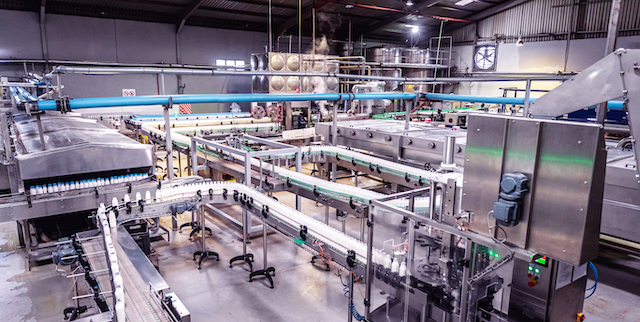News
ECS Eliminates Bottlenecks with Flexible Packaging Solution
Industrial systems are generally designed with a perfect balance between product manufacturing and packaging output. Changes to output requirements, product makeup, or packaging requirements frequently create imbalances known as process bottlenecks. The job of process and industrial engineers is to identify the slow points within the complete process and develop solutions to eliminate obstructions. Today’s solutions to a slow point in the middle of the line, for example, solve not only the current issue, but often highlight the next weakest link in the manufacturing chain and the process then repeats.
This situation is particularly prevalent in large-scale food manufacturing where systems designed to create one product are frequently adapted for future needs. Simple changes to ingredient makeup or quantities can upset the balance within processing systems or require the insertion of process steps that are outside of the equipment’s original intent. Perhaps just as frequent are changes in packaging that mandate the addition of new primary or secondary packaging machines to be used in conjunction with or instead of a line’s original machinery. All of these are good problems to have in that they indicate a flexible level of operation, and they create opportunities for manufacturers to support more customers with more products.
ECS Solutions, Inc. (ECS) deals with these situations on a regular basis. Their clients, among the nation’s leaders in manufacturing and packaging of multi-ingredient food products, are continually adapting their systems to appeal to a wider variety of product and client solutions. Simply put, their clients don’t stand still, and they rely on ECS to help them maintain their flexibility. ECS was recently engaged by a longtime client to eliminate a packaging bottleneck that required a significant change to a line’s layout. This customer manufactures a white sauce alfredo product and previous efforts identified the retort cooking operation as the slow point. Once an additional retort was installed the initial problem was alleviated but overall output was being hampered by the packaging line throughput capacity.
The original packaging line consisted of a typical filler/capper, labeler, case packer, and a palletizer along with the related coding, inspection, and conveyance accessories. The filler at the head of the line and palletizer at the opposite end both had additional capacity, but the labeler and case packer in the middle were operating at their maximum output. The solution was to create a parallel packaging route from a diverge near the discharge of the filler with a re-integration near the palletizer, which is in an entirely different area of the factory on another floor. The revised design incorporates a new labeler and case packer along with fifty-five new conveyors including conveyance, gapping, accumulation, and decline units.
The ECS control system handles the packaging load, now shared across the two parallel lines. It allows either side to ramp up and carry additional load if the opposite lane is partially or fully unavailable. Their solution included modifications to the two system controllers, the one that controls the filling and discharge functions, and a second that handles the bulk of the conveyor operations. Both controllers were upgraded to matching Rockwell Automation ControlLogix L71 series Programmable Automation Controllers (PACs). The upgraded PACs afforded program real estate to support the revised control schemes that account for operation across a wide variety of package sizes, configurations, and materials. ECS also adapted the code within the PACs to feed signals to the client’s internal OEE system so that monitoring could happen as soon as the revised equipment was operational.
ECS delivered a series of VFD panels that provide physical mounting space for the new Rockwell Automation PowerFlex 525 variable frequency drives (VFDs). These panels are strategically placed along the line to provide logical division and shortest run for installation purposes. The controllers’ upgrades created the ability to use specific VFD add-on instruction control blocks that streamline the installation and manipulation of control code. The flexibility of the new PACs and VFDs was immediately exploited to allow connection of VFDs to one of the controllers via daisy chain control wiring and use of a Device Level Ring configuration, a necessity due to space constraints within one existing VFD panel. The second controller’s VFDs were connected in a more traditional star-wired method with ethernet switches.
Operator interface is via a pair of Rockwell Automation PanelView+ 10” touchscreens, one from the original installation and the second as provided by ECS. These screens provide a means to control all components in both manual and automatic mode as well as to configure the parallel routes’ operation. System safety is integrated into the complete solution with each side’s conveyors configured in logical safety zones with detailed operational feedback provided to line operators.
Commissioning of the revised solution met with the usual array of complications that manufacturing brings, including the availability of components and machines created by the recent economic situation. ECS’ team flexed to meet a staggered installation schedule and the client has enjoyed a predictable, yet methodical, installation and startup despite the natural hitches. They’ve already seen easing in this bottleneck and expect full elimination of it once the final pieces are installed within the month. Then, it will be off to the next element and their partners at ECS Solutions stand ready to address that challenge as well.
Posted In: Bakery Industry, Beverage Industry, Food Industry

